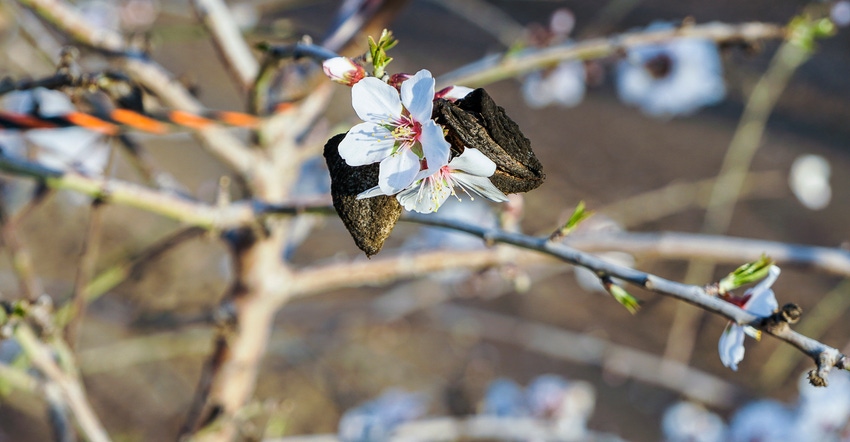
Almond growers by now should be working through their pre-harvest hull split sprays and activities to ensure Navel orangeworm damage doesn’t become the train wreck it was in 2017 when producers accustomed to receiving premium payments were instead being charged deductions by their processors.
As of mid-July some tree nut growers were indicating pest pressures lower than what they saw in 2017 and, in some cases, even lower than last year. Also lower to date appears to be the number of degree days, which scientists use to predict when new moth flights and insect mating will begin again.
Hull split sprays alone won’t cure the problem with a moth that researchers say creates feeding damage in almonds, pistachios and walnuts that can lead to molds that cause aflatoxin, a dangerous toxin and food safety concern. Still, growers are advised that to not use every tool available to control the pest is to throw money away.
Mel Machado, member relations director for the almond cooperative Blue Diamond, says a grower with 10 percent loss due to worm damage can lose $1,742 per acre on his pay scale, based on conservative production estimates. About 80 percent of the nut damage Machado sees at Blue Diamond is traced back to the Navel orangeworm (NOW).
The University of California says there are three to four adult flight periods of NOW moths per year, depending on emergence from overwintering stage and temperatures during the season. The proliferation of tree nut crops across the state has given these moths greater feeding and breeding opportunities – more so in the southern, warmer regions of the Central Valley growing region.
Harvest considerations
With harvest nearing growers are encouraged to get their crops out of the fields as quickly as possible. This is important across all nut crops, but critical in early variety walnuts, according to Eric Heidman, vice president of grower services at Diamond Foods.
Heidman cautioned growers at a Navel orangeworm symposium in Modesto recently that half his early-variety damage can be traced to NOW. The other half comes from coddling moth. He also cautioned growers to watch for sunburn damage in walnuts, which can make NOW feeding easier and lead to further damage.
Heidman had a chart showing potential revenue per acre impact with an early season variety producing an assumed 3,500 pounds per acre at 80 cents per pound. He shows where revenue can fall 11 percent with insect damage between 5 and 6 percent. Damage above 10 percent can quickly cost a grower 25-50 percent of his or her revenue stream.
Speakers at the Modesto grower symposium on NOW control had the same basic message for growers of the three big nut crops in California: it takes an integrated approach of pest control. This means growers cannot simply rely on insecticides, but nevertheless must use them properly in the context of a systems approach that includes mating disruption and winter sanitation. It’s becoming easier to show where a poor or mediocre effort of getting nuts left behind from the harvest process out of the fields and destroyed can make the difference between profit and loss.
Compounding the issue for some almond growers is the popularity of the Independence variety and the difficulty in shaking all the nuts from that tree, even after multiple attempts.
Food safety
Aflatoxins results from naturally occurring fungi, according to the University of California. The issue has become increasingly worrisome to tree nut farmers as these potent toxins and carcinogens are heavily tested for by trading partners.
Alexi Rodriguez of Campos Brothers Farms says NOW damage is more likely to cause the molds that lead to the development of aflatoxins. The resulting hypersensitivity to aflatoxins by trading partners is costing the industry lost product and market opportunities, Rodriguez said.
Systems Approach
Mating disruption and insecticides do work, but growers are encouraged to work closely with their pest control advisors and follow University of California guidelines to ensure the tandem approach doesn’t cancel out the benefits of one approach.
Still, and perhaps the most critical piece to this puzzle, is winter sanitation and the ability to remove all nuts from the orchard prior to January of each year. A good practice is to do this after the trees have defoliated, and rain and fog have moistened the nuts and made them easier to fall from the trees. This can mean an additional shake of the trees and the need to hire crews to knock nuts off the trees with poles before destroying them on the orchard floor through cultural practices that includes mowing and disking.
It’s not just enough to shake nuts to the ground, but to ensure no nuts remain in the crooks of almond or pistachio trees. It may even be necessary, one grower said, to use a blower to make sure all nuts end up on the ground and between the rows for mowing and disking.
Even at a cost of $150-$200 an acre to conduct these practices growers are continually told at industry meetings on the topic that the added cost of winter sanitation efforts can more than be recovered through increased production and bonus payments by the various processors.
About the Author(s)
You May Also Like






